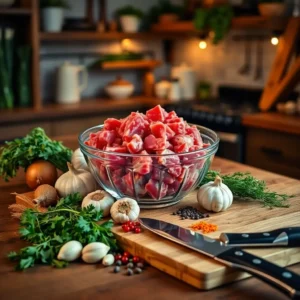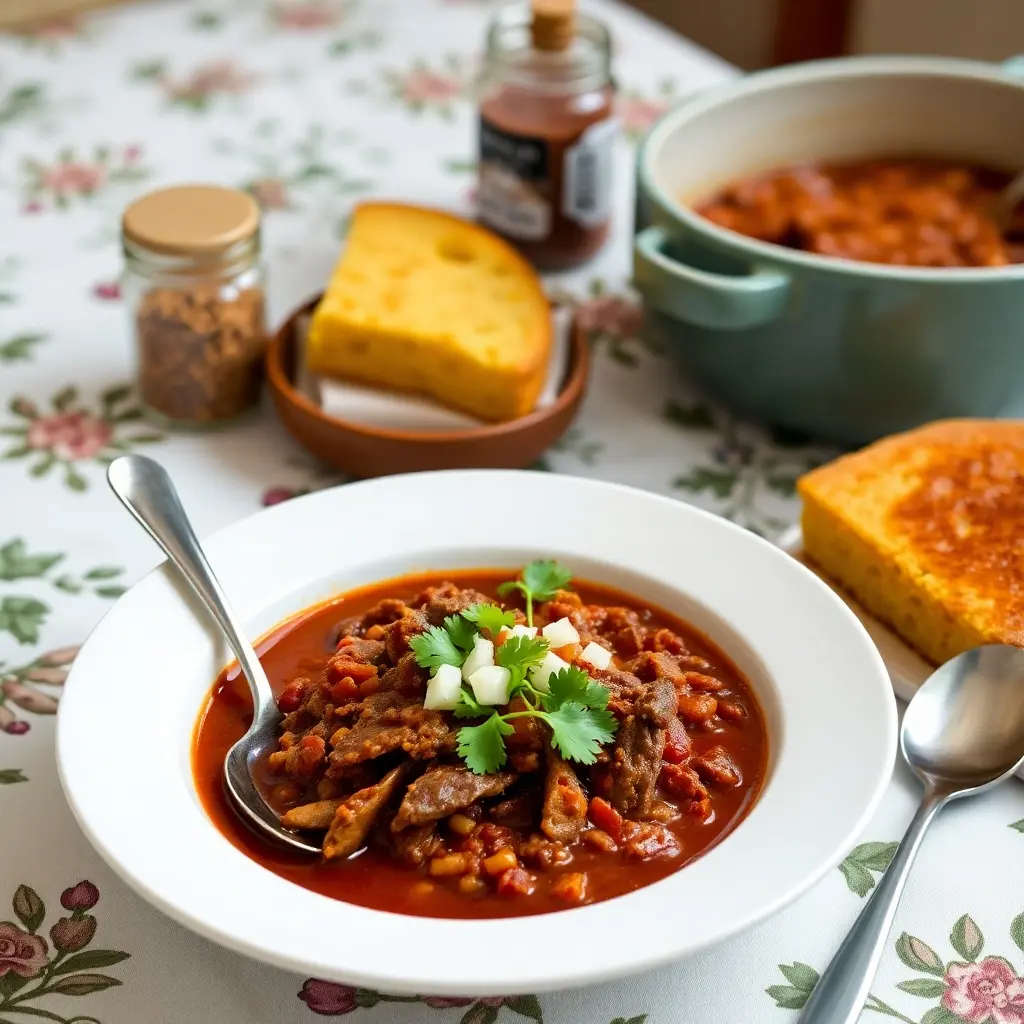When it comes to cooking with wild game, few ingredients are as versatile and delicious as ground deer meat. Packed with flavor, lean, and loaded with nutrients, it’s no wonder venison is a favorite among chefs and home cooks alike. This article will guide you through the best recipes, preparation tips, and nutritional insights to make the most of your ground deer meat. Whether you’re an experienced cook or just starting out, these ideas will inspire your next meal while keeping your dishes healthy and flavorful.
Part 1: Introduction to Ground Deer Meat
Understanding Venison: Definition and Types
Venison, often synonymous with deer meat, refers to the flesh of deer harvested for consumption. Unlike farm-raised meat, venison comes from animals in the wild, giving it a unique flavor profile that’s both earthy and rich. Ground deer meat is made by grinding venison cuts, such as shoulder or leg, and is prized for its versatility in recipes like chili, meatballs, and burgers.
Additionally, venison can come from different species of deer, like white-tailed deer, mule deer, or elk. Each variety offers subtle flavor differences, but all share the same lean texture that makes them perfect for health-conscious eaters.
Nutritional Benefits of Ground Deer Meat
If you’re looking for a protein-rich food that’s low in fat and high in vitamins, venison is hard to beat. Compared to beef, it has fewer calories and cholesterol while being packed with iron, zinc, and B vitamins. Plus, ground venison is ideal for those following paleo, keto, or other low-carb diets.
Eating wild game meat also provides an eco-friendly option since it relies on natural ecosystems rather than industrial farming. By choosing ground deer meat, you’re embracing a sustainable and nutritious way to enjoy protein-packed meals.
Sourcing and Selecting Quality Ground Venison
Finding high-quality ground deer meat ensures better taste and texture in your dishes. While some people prefer hunting and processing their own meat, many stores and specialty butchers offer ethically sourced venison. Look for meat that’s deep red with minimal fat marbling, as excessive fat can affect the flavor and freshness.
If you’re purchasing pre-ground venison, make sure it’s been frozen properly to preserve quality. For those seeking variety, check out this venison cooking guide for tips on handling and storing wild game meat.
Part 2: Preparing Ground Deer Meat for Cooking
Proper Thawing Techniques
 Before diving into your recipe, thawing ground deer meat correctly is crucial. Improper thawing can lead to uneven cooking or even spoilage. Ideally, you should thaw frozen venison in the refrigerator overnight, as this method maintains the meat’s texture and prevents bacterial growth. However, if you’re in a rush, submerging the sealed package in cold water is a quicker, safe alternative. Keep in mind, though, that microwaving to defrost should be avoided because it can partially cook the meat, which may lead to uneven results in your recipe.
Before diving into your recipe, thawing ground deer meat correctly is crucial. Improper thawing can lead to uneven cooking or even spoilage. Ideally, you should thaw frozen venison in the refrigerator overnight, as this method maintains the meat’s texture and prevents bacterial growth. However, if you’re in a rush, submerging the sealed package in cold water is a quicker, safe alternative. Keep in mind, though, that microwaving to defrost should be avoided because it can partially cook the meat, which may lead to uneven results in your recipe.
Seasoning and Marinating Tips
When it comes to flavoring ground deer meat, seasonings and marinades can make all the difference. Although venison has a natural, earthy taste, adding the right blend of spices can enhance its flavor without overpowering it. A mixture of garlic, rosemary, paprika, and black pepper works wonderfully. You can also use soy sauce or Worcestershire sauce (though not too much) as a marinade to boost umami flavors.
Marinate the meat for at least an hour before cooking, but if you have time, let it sit overnight to infuse the flavors deeply. Always pat the meat dry before cooking to help it sear properly, as excessive moisture can interfere with caramelization.
Addressing the Gamey Flavor: Myths and Facts
Many people hesitate to try venison due to its so-called “gamey” flavor, but much of that perception comes from improper preparation. While it’s true that wild game has a distinct taste, most of the “gamey” aspect can be minimized with correct handling. Removing the silver skin (a thin membrane on the meat) is essential, as this part often contributes to an unpleasant taste.
Additionally, cooking venison at the right temperature is key. Since it’s lean, overcooking can lead to dryness and intensify any strong flavors. For perfectly tender results, aim for medium-rare doneness and monitor it closely to avoid overheating.
Part 3: Top Ground Deer Meat Recipes
Venison Chili
One of the most beloved ways to prepare ground deer meat is by making venison chili. Not only is this dish hearty and flavorful, but it’s also incredibly versatile, allowing you to tweak the spice levels and ingredients to your liking.
Ingredients List:
- 1 lb of ground deer meat
- 1 can of diced tomatoes (14 oz)
- 1 can of kidney beans (14 oz)
- 1 diced onion
- 3 minced garlic cloves
- 2 tablespoons of chili powder
- 1 teaspoon of cumin
- Salt and pepper to taste
- 1 tablespoon of olive oil
Step-by-Step Cooking Instructions:
To start, heat the olive oil in a large pot over medium heat. Add the diced onion and garlic, cooking until they become fragrant. Next, add the ground deer meat, breaking it apart with a wooden spoon. Stir occasionally until the meat is browned evenly.
After that, stir in the chili powder, cumin, salt, and pepper, ensuring the spices coat the meat thoroughly. Pour in the diced tomatoes and kidney beans, then bring the mixture to a gentle boil. Once it starts bubbling, reduce the heat and let it simmer for 30 minutes. Stir occasionally to prevent sticking, and taste for seasoning adjustments as it cooks.
Serving Suggestions:
Serve your venison chili piping hot in bowls, garnished with fresh cilantro, diced onions, or shredded cheese. Pair it with a side of cornbread or tortilla chips for a complete meal that’s sure to impress!
 Venison Burgers
Venison Burgers
If you’re looking for a crowd-pleaser, venison burgers are a must-try. These patties pack all the flavor of a traditional burger while being leaner and healthier.
Ingredients List:
- 1 lb of ground deer meat
- 1 egg (optional, for binding)
- 1 teaspoon of garlic powder
- 1 teaspoon of onion powder
- Salt and pepper to taste
- 1 tablespoon of olive oil
Step-by-Step Cooking Instructions:
In a mixing bowl, combine the ground deer meat with garlic powder, onion powder, salt, and pepper. For added moisture, you can incorporate an egg. Form the mixture into evenly sized patties.
Heat the olive oil in a skillet or grill over medium-high heat. Cook each patty for about 4–5 minutes per side, or until they reach an internal temperature of 160°F. Avoid overcooking, as this can dry out the meat.
Serving Suggestions:
Place the patties on toasted buns with your favorite toppings, such as lettuce, tomatoes, pickles, or cheese. For a healthier twist, skip the bun and wrap the burger in a crisp lettuce leaf instead.
Venison Meatballs
Venison meatballs are a fantastic addition to pasta dishes or can be enjoyed on their own as appetizers.
Ingredients List:
- 1 lb of ground deer meat
- ½ cup of breadcrumbs
- 1 egg
- 1 teaspoon of Italian seasoning
- ½ teaspoon of garlic powder
- Salt and pepper to taste
Step-by-Step Cooking Instructions:
Mix the ground deer meat, breadcrumbs, egg, Italian seasoning, garlic powder, salt, and pepper in a bowl. Shape the mixture into small, evenly sized balls.
Cook the meatballs in a skillet with a tablespoon of olive oil over medium heat. Turn them frequently to ensure all sides brown evenly. Once cooked through, serve them with marinara sauce or a creamy gravy for a comforting meal.
Serving Suggestions:
Serve over spaghetti for a classic combination or alongside a salad for a lighter option. Either way, these meatballs are a hit!
Part 4: Cooking Techniques for Ground Venison
Pan-Searing and Sautéing
Pan-searing is one of the simplest yet most effective ways to prepare ground deer meat. It not only brings out the natural flavors but also creates a delicious caramelized crust. To begin, heat a non-stick or cast-iron skillet over medium heat and add a tablespoon of olive oil. Once the oil is hot, add the seasoned ground venison to the pan. Stir occasionally while pressing the meat gently with a wooden spoon to help it cook evenly.
For sautéing, the process is similar but involves additional ingredients like onions, garlic, or bell peppers. By tossing these vegetables into the pan with the venison, you’ll build layers of flavor that enhance your dish. Always cook until the meat is fully browned, which typically takes about 7–10 minutes. Importantly, avoid overcooking to preserve the tender texture of the lean venison.
Grilling Best Practices
Grilling is a popular choice for dishes like venison burgers or kebabs, as it imparts a smoky flavor that’s hard to resist. To start, preheat the grill to medium-high heat and lightly oil the grates to prevent sticking. Form the ground deer meat into patties or shape it around skewers for kebabs.
Place the venison on the grill and cook for approximately 4–5 minutes per side. Since venison is leaner than beef, it cooks faster, so keep an eye on it. Use a meat thermometer to ensure the internal temperature reaches 160°F, which guarantees food safety without sacrificing juiciness.
Baking and Roasting Methods
Baking and roasting are ideal for recipes like meatloaf or stuffed peppers using ground deer meat. Preheat your oven to 375°F for most dishes, as this temperature allows even cooking without drying out the meat. If you’re making a meatloaf, combine the venison with breadcrumbs, an egg, and your choice of seasonings before shaping it into a loaf pan. Bake for about 45 minutes, or until the internal temperature reaches 160°F.
Roasting is another option, especially for larger, prepared dishes. For instance, stuffed peppers filled with ground deer meat can be roasted in the oven for 25–30 minutes. Cover the dish with foil to retain moisture, and remove it in the final few minutes to achieve a lightly crisped top.
Why Cooking Techniques Matter
Using the right cooking techniques not only enhances the flavor but also ensures the meat stays juicy and tender. Given its lean nature, venison benefits from gentle cooking methods and careful monitoring. Experimenting with these techniques will give you confidence in preparing ground deer meat for any occasion.
Part 5: Nutritional Information and Considerations
Calorie and Protein Content
One of the standout features of ground deer meat is its remarkable nutritional profile. With approximately 130 calories and 26 grams of protein per 3-ounce serving, venison is an excellent choice for those seeking a lean yet protein-packed option. It’s lower in fat compared to ground beef or pork, which means you can enjoy hearty dishes without worrying about excessive calories or unhealthy fats.
This nutrient density also makes venison a favorite among athletes and fitness enthusiasts. Because it provides high-quality protein, it aids in muscle repair and supports overall health. Plus, its lower fat content makes it ideal for anyone focused on maintaining a balanced diet.
Comparing Venison to Other Meats
How does venison stack up against other popular proteins like chicken, turkey, or beef? In terms of leanness, ground deer meat is comparable to skinless chicken or turkey breast but offers a richer, more robust flavor. Compared to beef, venison has significantly fewer calories and less saturated fat while delivering comparable amounts of protein.
For those who prioritize iron intake, venison is a stellar choice. Its iron content surpasses that of chicken or turkey, making it an excellent option for preventing anemia or boosting energy levels. Furthermore, venison contains higher levels of zinc and B vitamins, both of which are essential for immune function and energy production.
Health Benefits and Dietary Considerations
Including venison in your meals not only supports a healthier lifestyle but also offers unique benefits for individuals with specific dietary needs. Its low fat and cholesterol levels make it ideal for heart-healthy diets, while its protein and nutrient content align well with paleo, keto, and low-carb eating plans.
Additionally, venison is free of the hormones and antibiotics often associated with commercially farmed meats. Because it comes from wild sources, it’s a cleaner protein option that aligns with sustainable and ethical food practices.
That said, some individuals may find the leanness of ground deer meat challenging for certain recipes, as it lacks the fat that helps bind or flavor dishes. In such cases, consider mixing it with a small amount of olive oil or another healthy fat to enhance texture and flavor without compromising its nutritional benefits.
By incorporating ground deer meat into your diet, you can enjoy delicious meals that not only satisfy your taste buds but also contribute to your overall well-being.
Part 6: Frequently Asked Questions
How do I make ground venison less dry?
Due to its low fat content, ground deer meat can sometimes turn out dry. To prevent this, mix the meat with a small amount of olive oil or an egg before cooking. Alternatively, combining it with fattier ground meat, such as ground turkey, can add moisture and improve the overall texture. Marinating the venison or cooking it over low heat can also help retain its natural juices.
Can I substitute ground venison for ground beef in recipes?
Absolutely! Ground deer meat is an excellent substitute for ground beef in virtually any recipe, from chili to burgers and even tacos. However, since venison is leaner, you may need to adjust the cooking time slightly or add a bit of fat to achieve a similar mouthfeel. Be mindful of its distinct flavor, which can be enhanced with complementary spices like garlic, thyme, and paprika.
What are the best spices to use with ground deer meat?
Spices like garlic powder, onion powder, rosemary, thyme, and black pepper work exceptionally well with ground deer meat. If you enjoy bolder flavors, you can add smoked paprika, chili powder, or cayenne for a bit of heat. For marinades, soy sauce or Worcestershire sauce adds depth, while a splash of lemon juice can balance the meat’s earthiness.
How should I store leftover cooked venison?
Once cooked, ground deer meat should be stored in an airtight container and refrigerated within two hours of preparation. It can remain fresh for up to three days in the fridge. If you’d like to keep it longer, freezing it is a great option. For best results, portion the meat into smaller containers and freeze it for up to three months.
Is it necessary to add fat to ground venison?
While it’s not strictly necessary, adding fat can improve the texture and flavor of ground deer meat, especially in recipes like burgers or meatloaf. Mixing in a tablespoon or two of olive oil or a small amount of ground pork can create a juicier final product. That said, many recipes can still turn out great without added fat if the venison is prepared correctly.
How can I tell when ground venison is fully cooked?
The safest way to ensure ground deer meat is fully cooked is by using a meat thermometer. For ground venison, the internal temperature should reach 160°F. Visually, the meat should be uniformly browned with no pink areas remaining. Overcooking can make the meat tough, so keeping a close eye on the temperature is crucial.

